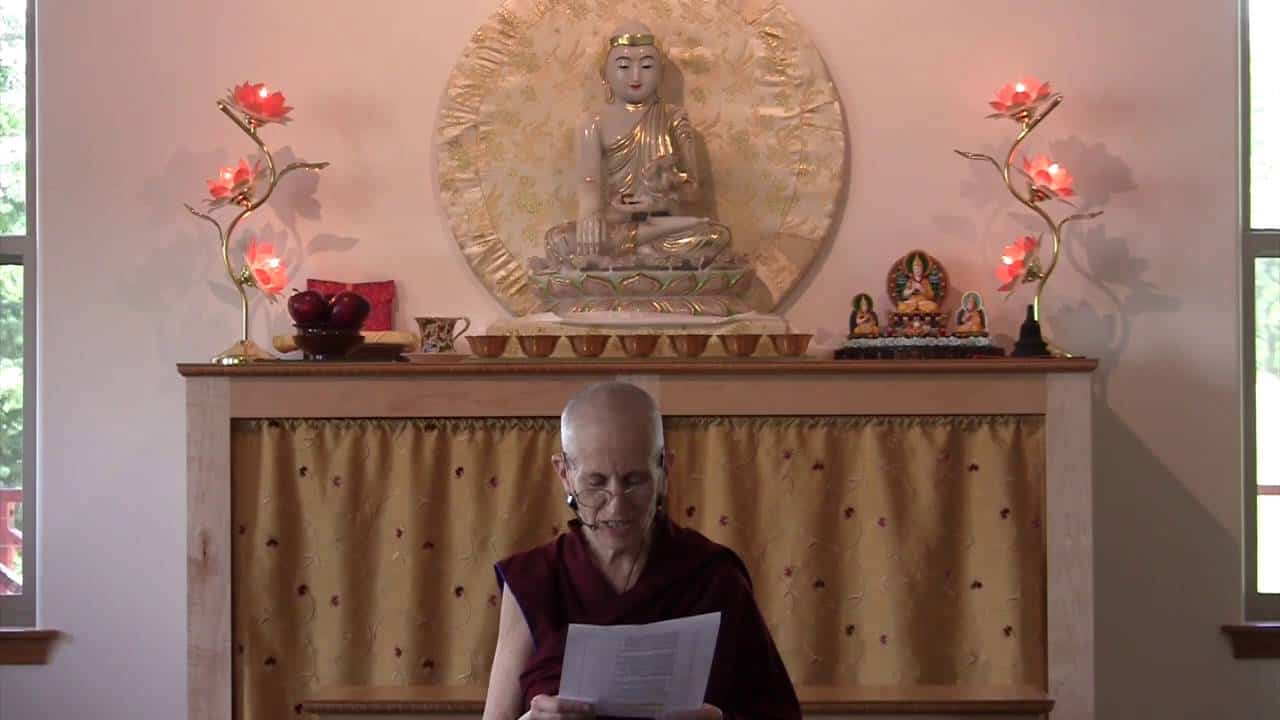Attachment, anger, and conceit
The text turns to training the mind on the stages of the path shared with intermediate level practitioners. Part of a series of teachings on the Gomchen Lamrim by Gomchen Ngawang Drakpa. Visit Gomchen Lamrim Study Guide for a full list of contemplation points for the series.
- Identifying the root afflictions
- Attachment
- Anger
- The nine reasons we use to validate anger
- Conceit
- Seven kinds of conceit according from Vasubandu’s Treasury of Knowledge
- The seven forms of conceit according to Nagarjuna’s Precious Garland
- The antidotes
Gomchen Lamrim 46: Attachment, anger and conceit (download)
Contemplation points
- We’ve spent the last few months looking at karma and the last couple weeks looking at the first truth of the Aryas: the truth of dukkha. Take some times to explore your understanding of karma and its effects, and of this truth of dukkha, relating it to current events as Venerable Chodron did in the introduction to the teachings.
- How does a deeper understanding of these teachings help you to process the attack at the nightclub in Orlando, the two year old boy who was snatched from his parents by the alligator, other situations you might have news of in your own area of the world.
- Contemplating in this way helps to punctuate the importance of what we do with this life. With these understandings firmly in mind, what do you want to do with the time you have left in this life? What do you want to avoid doing?
- Next, we move onto the truth of the origins of dukkha. Consider that not only do afflictions cause the creation of karma, but they must be present for the results to ripen. Think about your experience of this.
- When you were acting in a way that was non-virtuous, can you identify the affliction that was present in your mind?
- When you have experienced dukkha, can you identify the affliction that was present that enabled the dukkha to ripen? Take some time with this.
- Venerable Chodron taught on the first three of the root afflictions (attachment, anger, and conceit). Examine each:
- Attachment exaggerates the attractiveness of a polluted object, takes a strong interest in it, clings to it, and wants to possess it. There are many degrees and variation of attachment, but they all share that factor of exaggerating and clinging. Think of how attachment operates in your life. What are you attached to? Give specific examples. Venerable Chodron said that all attachment in the desire realm is non-virtuous. Are there ways you rationalize your attachment? How does attachment harm yourself and others?
- Anger exaggerates the defects of people, places, things, ideas, etc with the wish to harm or distance ourselves from them; it is the fight or flight response. Think of how anger operates in your life. What triggers your anger (remember there are many forms of anger like frustration, annoyance, hatred, righteous anger…)? Are there ways you rationalize your anger? Consider specific examples of anger in your life using the nine reasonings that we use to justify our anger. How does anger harm yourself and others?
- Conceit is an inflated sense of self based on the view of a personal identity, it grasps at “I” or “my.” Venerable Chodron said we can get conceited over the tiniest things. Think of specific ways conceit operates in your life. How does conceit harm yourself and others?
- Seeing how these afflictions operate in your life, leading you to create negativities and the conditions under which you experience dukkha, resolve to watch for them in your life and apply the antidotes throughout the week.
Venerable Thubten Chodron
Venerable Chodron emphasizes the practical application of Buddha’s teachings in our daily lives and is especially skilled at explaining them in ways easily understood and practiced by Westerners. She is well known for her warm, humorous, and lucid teachings. She was ordained as a Buddhist nun in 1977 by Kyabje Ling Rinpoche in Dharamsala, India, and in 1986 she received bhikshuni (full) ordination in Taiwan. Read her full bio.


